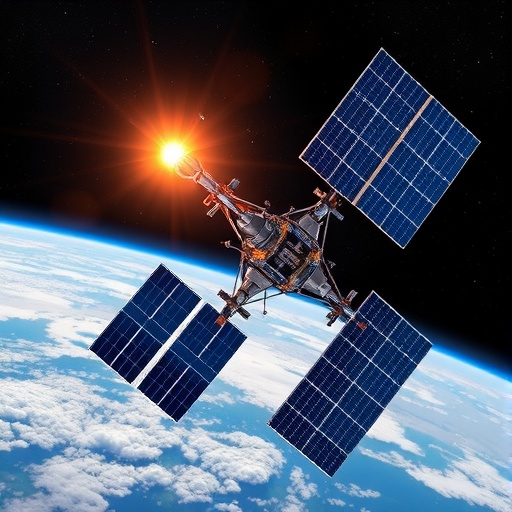In a groundbreaking study published in the esteemed journal Joule, researchers have opened the door to the realm of space-based solar energy, presenting an innovative solution to power generation that could revolutionize Europe’s energy landscape. As the world faces the urgent challenge of climate change, this new research emphasizes the potential of solar power harvested from space, which could drastically reduce Europe’s reliance on traditional Earth-bound renewable sources like wind and solar power by up to 80% by the year 2050.
What sets this concept apart is the unique advantage of positioning solar panels in space, where they can continuously face the sun, allowing for near-constant energy generation compared to the intermittent nature of solar power on Earth. This ongoing accessibility to sunlight dramatically enhances the efficiency of solar energy harvesting. Wei He, a senior author and engineer from King’s College London, notes that in the vacuum of space, solar radiation is significantly stronger than on the Earth’s surface. This ability to harvest solar energy constantly presents an opportunity that, if realized, could fundamentally alter the dynamics of energy production in Europe.
Historically, the notion of deploying solar panels in space is not novel, as it was initially proposed in 1968. However, advancements in technology and reductions in costs have made what once seemed like a distant dream much more attainable. Today, several nations—including China, India, Japan, Russia, the United States, and the United Kingdom—are actively pursuing their own initiatives to develop space-based solar power systems, recognizing the potential benefits of this approach.
The practical function of space-based solar panels mimics that of communications satellites. These solar arrays would orbit the Earth, rotating to optimize their exposure to sunlight. The harvested energy would then be transmitted to receiving stations on Earth in the form of microwaves. Once received, these microwaves could be converted back into electricity and integrated into the existing grid infrastructure, ultimately providing a steady and reliable power source.
In their study, the researchers employed energy models to assess the potential impact of integrating space-based solar power into Europe’s energy system by the year 2050. This involved a thorough analysis of two distinct designs from NASA: the Innovative Heliostat Swarm and the Mature Planar Array. The heliostat design, while still in its nascent stages of development, shows extraordinary promise for capturing solar energy continuously, offering a substantial increase in efficiency over existing Earth-based systems.
Conversely, the planar design, while technologically easier to realize due to its maturity, captures solar energy only around 60% of the time. This still represents a significant improvement compared to the typical efficiency rates of 15% to 30% for standard terrestrial solar panels. However, the researchers find themselves at a critical juncture—a defining moment where space-based solar power can be tested on a large scale, advancing discussions around the regulatory frameworks and policies necessary for this new energy frontier.
When contrasting future scenarios both with and without the implementation of space-based solar technology, the team discovered that the heliostat design could outperform conventional wind and solar power systems by the year 2050, making a compelling case for investment in this realm. They estimate that the heliostat design alone could slash total system costs by between 7% and 15% while significantly curtailing the reliance on wind and solar generation, thus mitigating the need for extensive battery storage.
Despite these promising projections, achieving cost-effective solutions remains a major challenge. For the heliostat design to be viable, researchers estimate that the annual costs must drop to around 14 times the projected costs of Earth-based solar panels for 2050. Similarly, the planar design must achieve cost efficiencies approximating nine times the cost of its terrestrial counterparts. Currently, these cost metrics are approximately one to two orders of magnitude higher, necessitating innovative breakthroughs and aggressive research and development strategies.
The quest for success does not hinge solely on reducing costs. The researchers emphasize the importance of advancing wireless transmission technologies for energy transfer and the capability for automated assembly of solar devices in orbit. This crucial step underscores the fact that while the concept is robust, several technological hurdles must be overcome before space-based solar power becomes an operational reality.
Moreover, as this research progresses, it is critical to consider potential risks associated with space-based systems, such as the challenge of orbital debris and the potential degradation of the solar panels over time. He expresses a commitment to explore these issues to ensure that the future of solar power is not only sustainable but also safe for continued operations in the space environment.
This research not only lays the groundwork for the possible integration of space-based solar power into European energy frameworks but also reflects the growing consensus that innovative solutions must be pursued to achieve carbon neutrality. As the world grapples with the ramifications of climate change, these emerging technologies offer a glimmer of hope that sustainable energy solutions can be realized, transforming the way we think about energy production and consumption worldwide.
In summary, the potential of space-based solar panels offers a transformative shift in the energy paradigm, particularly for Europe. Coupled with rigorous scientific exploration and technological refinement, such initiatives could indeed help pave the path toward a net-zero future, emphasizing the critical importance of innovation in overcoming energy production challenges in the 21st century.
Subject of Research: Space-based solar power for power system decarbonization in Europe
Article Title: Assess space-based solar power for European-scale power system decarbonization
News Publication Date: 21-Aug-2025
Web References: Joule
References: Che et al., “Assess space-based solar power for European-scale power system decarbonization,” Joule
Image Credits: Wei He
Keywords
Solar energy, Photovoltaics, Space technology




